The AMD Ryzen 7 5700G, Ryzen 5 5600G, and Ryzen 3 5300G Review
by Dr. Ian Cutress on August 4, 2021 1:45 PM ESTCPU Tests: Synthetic
Most of the people in our industry have a love/hate relationship when it comes to synthetic tests. On the one hand, they’re often good for quick summaries of performance and are easy to use, but most of the time the tests aren’t related to any real software. Synthetic tests are often very good at burrowing down to a specific set of instructions and maximizing the performance out of those. Due to requests from a number of our readers, we have the following synthetic tests.
Linux OpenSSL Speed: SHA256
One of our readers reached out in early 2020 and stated that he was interested in looking at OpenSSL hashing rates in Linux. Luckily OpenSSL in Linux has a function called ‘speed’ that allows the user to determine how fast the system is for any given hashing algorithm, as well as signing and verifying messages.
OpenSSL offers a lot of algorithms to choose from, and based on a quick Twitter poll, we narrowed it down to the following:
- rsa2048 sign and rsa2048 verify
- sha256 at 8K block size
- md5 at 8K block size
For each of these tests, we run them in single thread and multithreaded mode. All the graphs are in our benchmark database, Bench, and we use the sha256 results in published reviews.

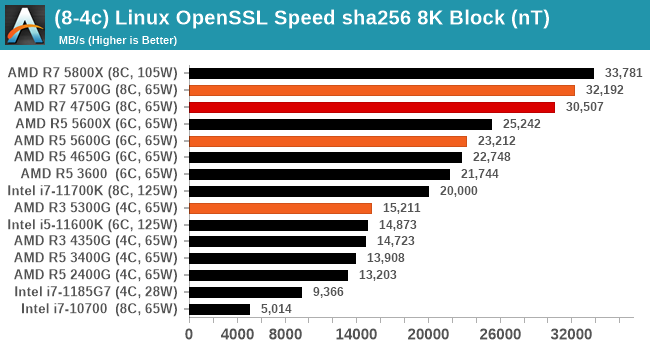
GeekBench 5: Link
As a common tool for cross-platform testing between mobile, PC, and Mac, GeekBench is an ultimate exercise in synthetic testing across a range of algorithms looking for peak throughput. Tests include encryption, compression, fast Fourier transform, memory operations, n-body physics, matrix operations, histogram manipulation, and HTML parsing.
I’m including this test due to popular demand, although the results do come across as overly synthetic, and a lot of users often put a lot of weight behind the test due to the fact that it is compiled across different platforms (although with different compilers).
We have both GB5 and GB4 results in our benchmark database. GB5 was introduced to our test suite after already having tested ~25 CPUs, and so the results are a little sporadic by comparison. These spots will be filled in when we retest any of the CPUs.
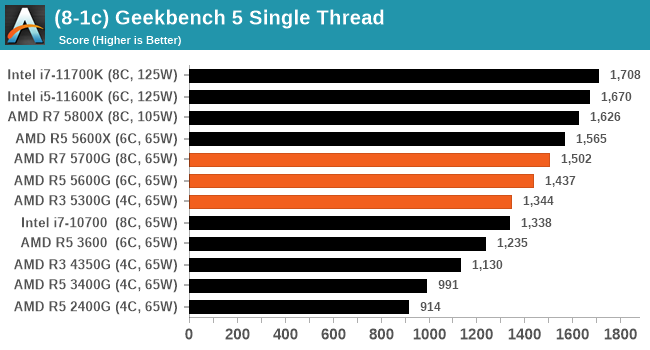
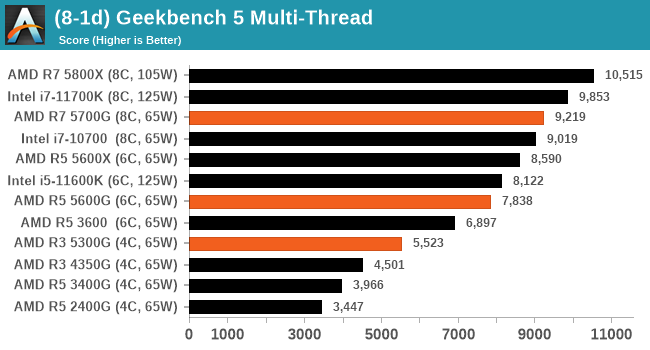
CPU Tests: SPEC
SPEC2017 and SPEC2006 is a series of standardized tests used to probe the overall performance between different systems, different architectures, different microarchitectures, and setups. The code has to be compiled, and then the results can be submitted to an online database for comparison. It covers a range of integer and floating point workloads, and can be very optimized for each CPU, so it is important to check how the benchmarks are being compiled and run.
We run the tests in a harness built through Windows Subsystem for Linux, developed by our own Andrei Frumusanu. WSL has some odd quirks, with one test not running due to a WSL fixed stack size, but for like-for-like testing is good enough. SPEC2006 is deprecated in favor of 2017, but remains an interesting comparison point in our data. Because our scores aren’t official submissions, as per SPEC guidelines we have to declare them as internal estimates from our part.
For compilers, we use LLVM both for C/C++ and Fortan tests, and for Fortran we’re using the Flang compiler. The rationale of using LLVM over GCC is better cross-platform comparisons to platforms that have only have LLVM support and future articles where we’ll investigate this aspect more. We’re not considering closed-sourced compilers such as MSVC or ICC.
clang version 10.0.0
-Ofast -fomit-frame-pointer
-march=x86-64
-mtune=core-avx2
-mfma -mavx -mavx2
Our compiler flags are straightforward, with basic –Ofast and relevant ISA switches to allow for AVX2 instructions. We decided to build our SPEC binaries on AVX2, which puts a limit on Haswell as how old we can go before the testing will fall over. This also means we don’t have AVX512 binaries, primarily because in order to get the best performance, the AVX-512 intrinsic should be packed by a proper expert, as with our AVX-512 benchmark. All of the major vendors, AMD, Intel, and Arm, all support the way in which we are testing SPEC.
To note, the requirements for the SPEC licence state that any benchmark results from SPEC have to be labelled ‘estimated’ until they are verified on the SPEC website as a meaningful representation of the expected performance. This is most often done by the big companies and OEMs to showcase performance to customers, however is quite over the top for what we do as reviewers.
For each of the SPEC targets we are doing, SPEC2006 1T, SPEC2017 1T, and SPEC2017 nT, rather than publish all the separate test data in our reviews, we are going to condense it down into a few interesting data points. The full per-test values are in our benchmark database.
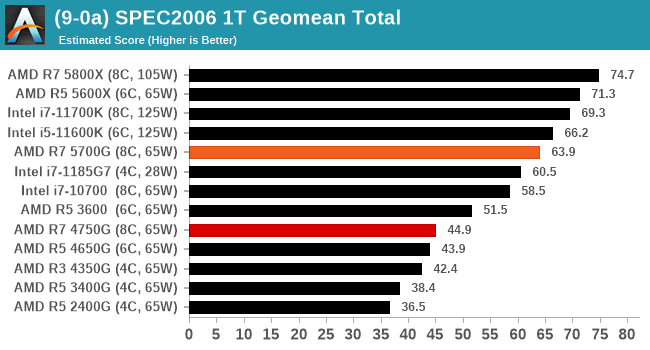
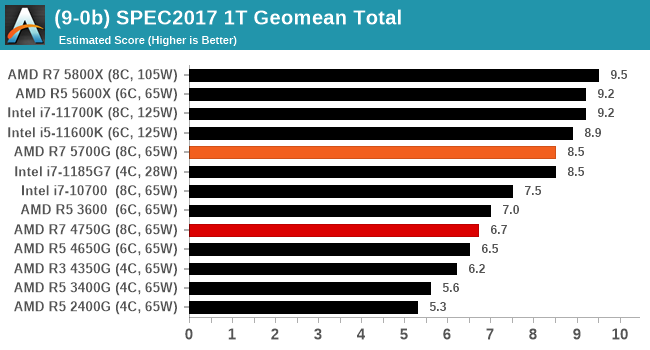
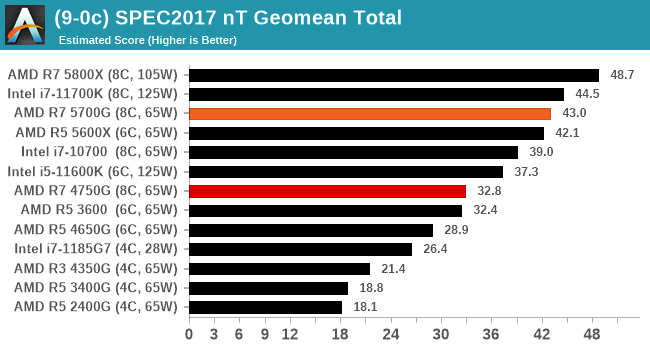
We’re still running the tests for the Ryzen 5 5600G and Ryzen 3 5300G, but the Ryzen 7 5700G scores strong.










135 Comments
View All Comments
DanNeely - Wednesday, August 4, 2021 - link
"What makes these ones different this time around is that Intel is cutting the Ryzen 3 from retail,"AND here, not Intel.
dwillmore - Wednesday, August 4, 2021 - link
And they use Zen3 *processors*, not graphics.Rudde - Wednesday, August 4, 2021 - link
“As it stands, these two new processors at retail fill out Intel’s retail offerings, at least down to $259.”Again, it is AMD's retail offerings.
at_clucks - Wednesday, August 4, 2021 - link
Intel features prominently at the forefront of Ian's conscious mind. :)abufrejoval - Wednesday, August 4, 2021 - link
I thought that was pretty funny, but after so many years of reviewing CPUs perhaps it does become a bit tiresome.This chips would have made a huge wave two years ago and still received raving reviews a year ago.
Today it's still excellent, but no longer that exciting.
Good value, through.
nandnandnand - Wednesday, August 4, 2021 - link
Vega is showing its age. We all know the next big APU is Rembrandt with RDNA 2 graphics. After that, maybe Strix Point (rumored big/little).vlad42 - Thursday, August 5, 2021 - link
Rembrandt will most likely use RDNA1 as AMD just recently submitted drivers to the Linux kernel for a new RDNA1 based APU. It is unlikely they are planning to release another APU given we have not heard any rumors to that effect. Though I would love to be wrong!nandnandnand - Thursday, August 5, 2021 - link
No, it will use RDNA 2, just like Van Gogh (Steam Deck). That RDNA 1 APU is probably some embedded part.vlad42 - Thursday, August 5, 2021 - link
I have seen no indication of such a part from the roadmaps AMD has presented in the shareholder meetings. Every official roadmap has shown Van Gogh, Rembrandt and if I remember correctly, some other iteration of Renoir/Lucienne. Given that every previous embedded chip has just been a variation of the laptop/desktop SKUs, it is highly unlikely they would hide the existence of a new dedicated embedded chip from investors (they can get sued over that!).I guess it could be a semicustom part where the customer wants open source Linux drivers?
Remember how all the late stage rumors claimed Renoir and then Cezanne would use RDNA1, while the early rumors for both claimed Vega? New rumors that pop up in the months leading up to a new chip launch claiming radical technology changes from previous rumors, such as a change in GPU architecture, are normally wrong/bogus.
It seems more realistic to temper expectations and assume Rembrandt will use RDNA1 given the driver submission, fact that all early rumors suggested so, and that it is the only other APU we know of that is releasing in the near future.
vlad42 - Thursday, August 5, 2021 - link
Just saw your post down below. I must have missed that Yellow Carp was for an APU as well. For some reason, I thought it was for the entry level discrete market.Maybe I missed that there is a new embedded market chip (it's not like they get much news coverage) or it is a semicustom part like I suggested above. It seems too early for Yellow Carp to be for the Zen4 based APUs unless they are coming sooner than we think or AMD is starting to upstream driver work earlier.